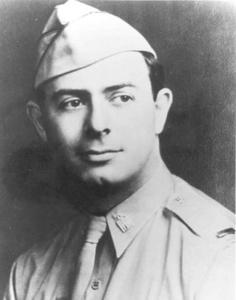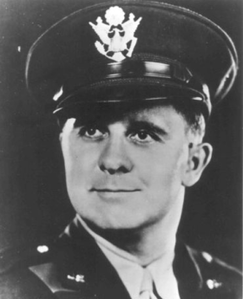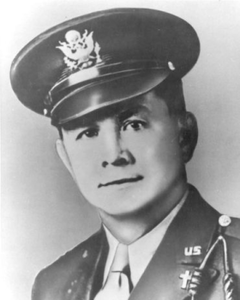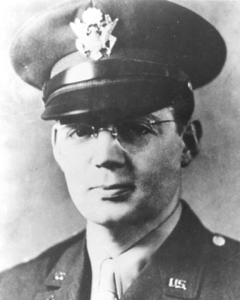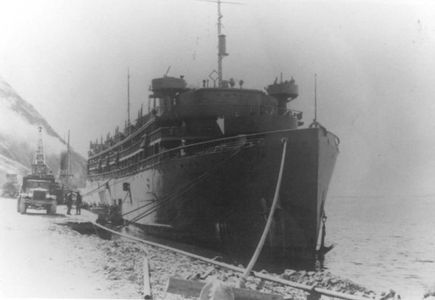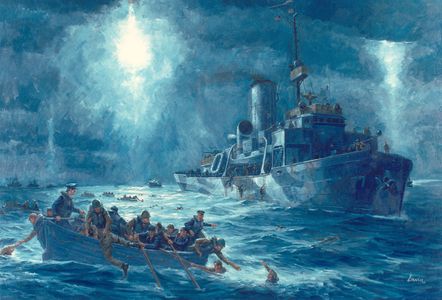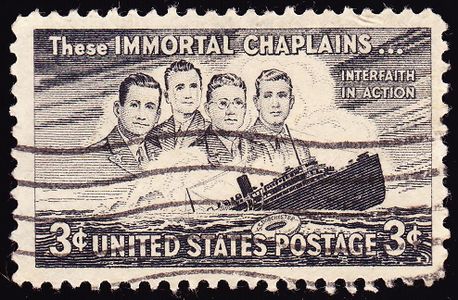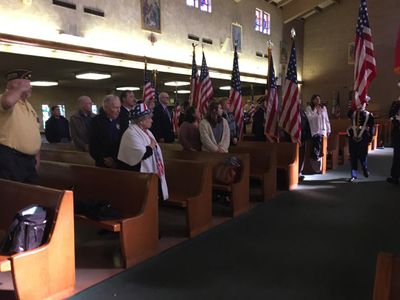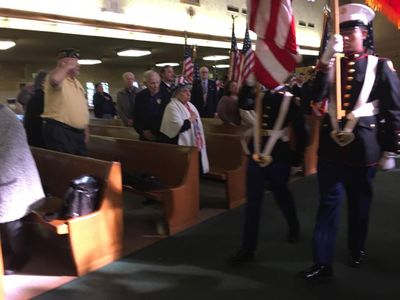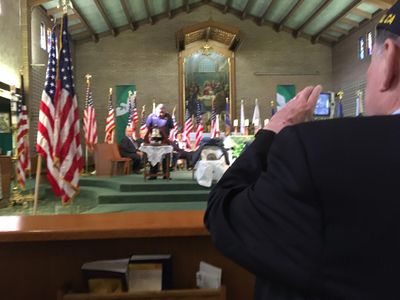Four Chaplains: Difference between revisions
No edit summary Tag: Manual revert |
No edit summary |
||
| Line 84: | Line 84: | ||
: Ceremony closed with a bagpipe tribute, a "Two Bell Ceremony" (by FRA-101}. | : Ceremony closed with a bagpipe tribute, a "Two Bell Ceremony" (by FRA-101}. | ||
: Taps was played, followed by the Benediction and the retiring of Colors | : Taps was played, followed by the Benediction and the retiring of Colors | ||
{{Nexus Navy days}} | |||
{{footer}} [[Category:US Navy]] | {{footer}} [[Category:US Navy]] | ||
Latest revision as of 23:23, 14 November 2023
Story of the Four Chaplains
The Four Chaplains met in the Navy and went through Navy Chaplains School together.
During WWII, a ship convoy was passing through "torpedo alley" some 100 miles off Greenland. The convoy was spotted by a German submarine, U-233. Three torpedoes were fired, striking three identical troopships, the Chatham, Fairfax and Dorchester. These ships were originally designed for the coastal trade with a capacity for 302 first-class and 12 steerage passengers for a total of 314 with a crew of 90 along the East Coast between Miami and Boston. On this trip to England, roughly 900 men on each of the three ships.
At about one am on February 3, 1943, the Dorchester was sighted by German submarine U-233.
The four chaplains on board, 1st Lt Clark V. Poling (Dutch Reformed Church), Alexander D. Goode (Jewish), John P Washington (Catholic), and George L. Fox (Methodist), were among the first on deck, calming the fears and handing out life jackets. When there were no life jackets, the chaplains removed theirs and gave them to four young men, without regard to faith or race, understanding fully the consequences of their decision. Approximately 18 minutes after the explosion, the ship went down. The Four Chaplains were last seen by witnesses, standing arm-in-arm on the hull of the Dorchester, each praying in his own way for their families and their own souls. Only 280 of the 902 men on board survived. Many of the men in the water said it was hearing the voices of the Four Chaplains preaching encouragement that kept them going.
- The Four Chaplins
From Wikipedia
The Four Chaplains, also referred to as the "Immortal Chaplains" or the "Dorchester Chaplains," were four World War II chaplains who gave their lives to save other civilian and military personnel as the troopship SS Dorchester sank on February 3, 1943. The Dorchester was a civilian liner converted for military service in World War II as a War Shipping Administration troop transport. She was able to carry slightly more than 900 military passengers and crew.
The ship left New York on January 23, 1943, en route to Greenland, carrying approximately 900 others, as part of a convoy of three ships escorted by Coast Guard Cutters Tampa, Escanaba, and Comanche. During the early morning hours of February 3, the vessel was torpedoed by the German submarine U-223 off Newfoundland in the North Atlantic. The chaplains helped the other soldiers' board lifeboats and gave up their own life jackets when the supply ran out. The chaplains joined arms, said prayers, and sang hymns as they went down with the ship.
The impact of the chaplains' story was deep, with many memorials and coverage in the media. Each of the four chaplains was posthumously awarded the Distinguished Service Cross and the Purple Heart. The chaplains were nominated for the Medal of Honor but were found ineligible as they had not engaged in combat with the enemy. Instead, Congress created a medal for them, with the same weight and importance as the Medal of Honor.
Cultural impact
In film
- The 60-minute TV documentary The Four Chaplains: Sacrifice at Sea was produced in 2004.
- It was announced in 2008 that the development of a movie based on the chaplains' story, titled Lifeboat 13, had begun. As of January 2013, however, no further information had been released about the project.
In print
- Francis Beauchesne Thornton (1953). Sea of Glory: The Magnificent Story of the Four Chaplains. Prentice Hall. LCCN 52010662. OCLC 1349281.
- Dan Kurzman (2004). No Greater Glory: The Four Immortal Chaplains and the Sinking of the Dorchester in World War II. Random House. isbn 978-0375508776. OCLC 53019525.
- Wales, Ken; Poling, David (2006). Sea of Glory: Based on the True WW II Story of the Four Chaplains and the USAT. Dorchester. B&H Publishing Group. isbn 978-0805443806 – via Google Books. As the title indicates, it is "based on" the story, not an actual factual account.
"Chaplains at War". The Living Bible (comic). March 1946.
- Edgar A. Guest (1949). Four Men of God. Living the Years. Reilly & Lee Company.
In music
- A composition entitled "The Light Eternal," written by James Swearingen in 1992, tells the story of the Four Chaplains through music.
- "The Ballad of the Four Chaplains" written and performed by Dead Men's Hollow
In art
In addition to the stained glass windows recalling the chaplains and their heroism, paintings include
- Four Chaplains, 1943, by Alton Tobey
- "A Moment of Peace," Ft. Jackson, South Carolina, painted by Steven Carter.1
- The Four Chaplains, Chapel of Four Chaplains.
- "The Four Chaplains," by Art Seidan (the four, pictured at the rail of the ship).
- Four chaplains mural, by artist Connie Burns Watkins, commissioned by the Rotary Club of York, Pennsylvania.[27]
- Four Chaplains mural, painted by Dean Fausett, at the entrance to Joseph "Ziggy" Kahn Gymnasium, Jewish Community Center Irene Kaufman Building, Squirrel Hill, Pennsylvania.
- "Four Chaplains mural", painted by Connie Burns Watkins, in York, Pennsylvania.
- Four Chaplains mural, painted by Nils Hogner, at the Chapel of Four Chaplains
- Four Chaplains monument and eternal flame, River view park, Sebastian Florida
Other
- The two-hour audio documentary "No Greater Love" tells the story, including interviews with survivors, rescuers, and naval historians.
- The 23rd degree conferred by the Ancient Accepted Scottish Rite Northern Masonic Jurisdiction, entitled "Knight of Valor" tells the story of the four chaplains as a lesson of personal sacrifice to aid one's fellow man.
Remembrance
Awards
Four Chaplains' Medal
On December 19, 1944, all four chaplains were posthumously awarded the Purple Heart and the Distinguished Service Cross.
External links
- https://en.wikipedia.org/wiki/Four_Chaplains
- https://en.wikipedia.org/wiki/SS_Dorchester
- https://en.wikipedia.org/wiki/Four_Chaplains%27_Medal
A Personal Note from Robin
In 2020, I joined the Fleet Reserve Association (FRA). The FRA is a veterans organization (like the American Legion) except it is specifically for Navy active-duty personnel and veterans. On February 1st of 2020, I attended the "Four Chaplains Ceremony" in San Jose, California.
- Four Chaplains Ceremony, 3 Feb 2020, San Jose, CA
Order of Service
- The service began with a bugler playing "Call to Church"
- Color Guards presented The Colors and followed by a flag and banner procession
- Invocation, Pledge of Allegiance, and National Anthem
- The story of the Dorchester was read.
- Four Ceremonial Honor Guards approached the dais and placed a battle helmet and a life preserver on each of the four empty chairs.
- The biographies of each of The Four Chaplains were read.
- Ceremony closed with a bagpipe tribute, a "Two Bell Ceremony" (by FRA-101}.
- Taps was played, followed by the Benediction and the retiring of Colors
 Main article: Navy Days
Main article: Navy Days
"Sea Stories" (NOT!) |
Wikipedia links to various duty stations: |
Chat rooms • What links here • Copyright info • Contact information • Category:Root
